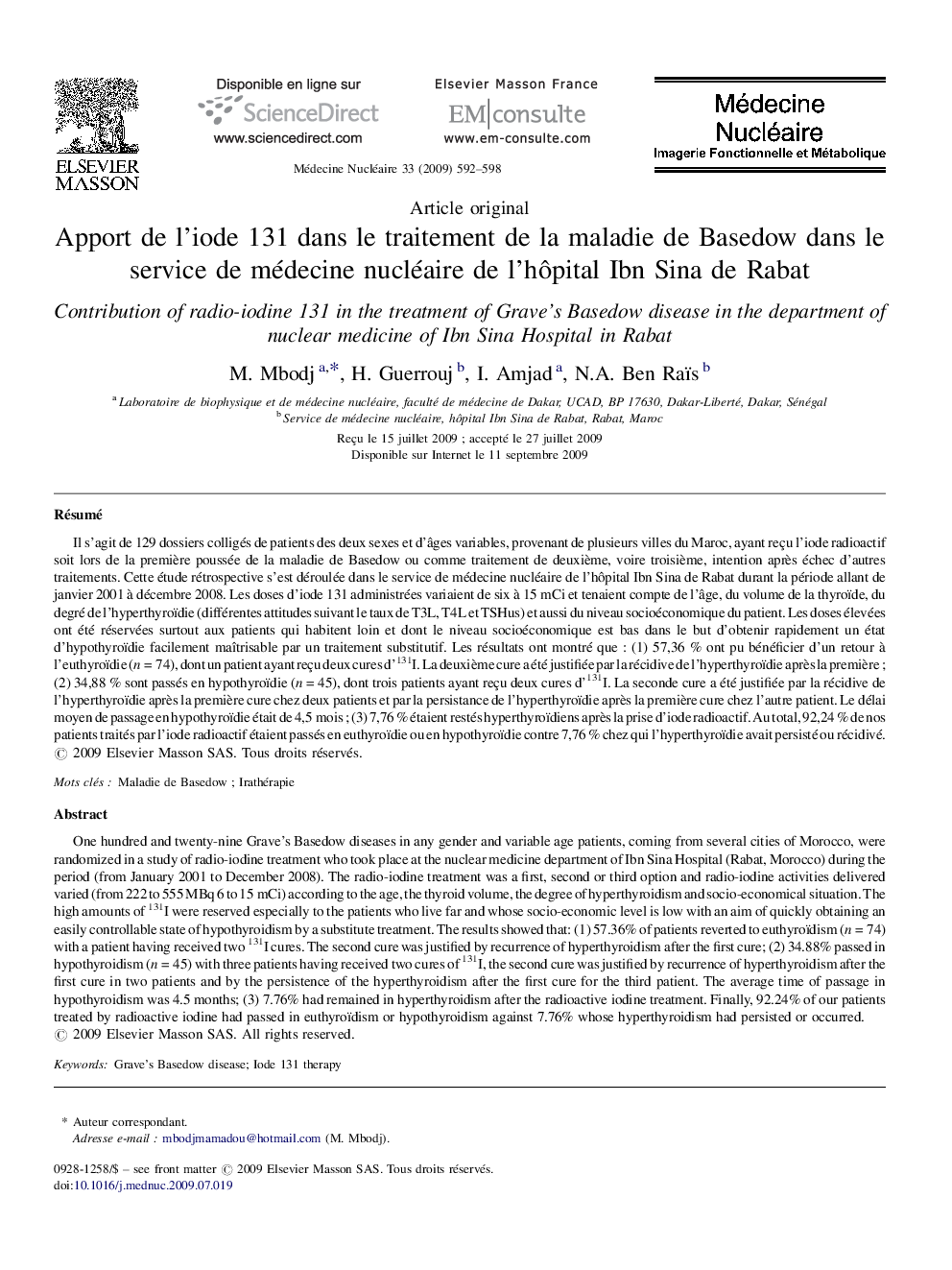| کد مقاله | کد نشریه | سال انتشار | مقاله انگلیسی | نسخه تمام متن |
|---|---|---|---|---|
| 4244417 | 1283392 | 2009 | 7 صفحه PDF | دانلود رایگان |

RésuméIl s’agit de 129 dossiers colligés de patients des deux sexes et d’âges variables, provenant de plusieurs villes du Maroc, ayant reçu l’iode radioactif soit lors de la première poussée de la maladie de Basedow ou comme traitement de deuxième, voire troisième, intention après échec d’autres traitements. Cette étude rétrospective s’est déroulée dans le service de médecine nucléaire de l’hôpital Ibn Sina de Rabat durant la période allant de janvier 2001 à décembre 2008. Les doses d’iode 131 administrées variaient de six à 15 mCi et tenaient compte de l’âge, du volume de la thyroïde, du degré de l’hyperthyroïdie (différentes attitudes suivant le taux de T3L, T4L et TSHus) et aussi du niveau socioéconomique du patient. Les doses élevées ont été réservées surtout aux patients qui habitent loin et dont le niveau socioéconomique est bas dans le but d’obtenir rapidement un état d’hypothyroïdie facilement maîtrisable par un traitement substitutif. Les résultats ont montré que : (1) 57,36 % ont pu bénéficier d’un retour à l’euthyroïdie (n = 74), dont un patient ayant reçu deux cures d’131I. La deuxième cure a été justifiée par la récidive de l’hyperthyroïdie après la première ; (2) 34,88 % sont passés en hypothyroïdie (n = 45), dont trois patients ayant reçu deux cures d’131I. La seconde cure a été justifiée par la récidive de l’hyperthyroïdie après la première cure chez deux patients et par la persistance de l’hyperthyroïdie après la première cure chez l’autre patient. Le délai moyen de passage en hypothyroïdie était de 4,5 mois ; (3) 7,76 % étaient restés hyperthyroïdiens après la prise d’iode radioactif. Au total, 92,24 % de nos patients traités par l’iode radioactif étaient passés en euthyroïdie ou en hypothyroïdie contre 7,76 % chez qui l’hyperthyroïdie avait persisté ou récidivé.
One hundred and twenty-nine Grave's Basedow diseases in any gender and variable age patients, coming from several cities of Morocco, were randomized in a study of radio-iodine treatment who took place at the nuclear medicine department of Ibn Sina Hospital (Rabat, Morocco) during the period (from January 2001 to December 2008). The radio-iodine treatment was a first, second or third option and radio-iodine activities delivered varied (from 222 to 555 MBq 6 to 15 mCi) according to the age, the thyroid volume, the degree of hyperthyroidism and socio-economical situation. The high amounts of 131I were reserved especially to the patients who live far and whose socio-economic level is low with an aim of quickly obtaining an easily controllable state of hypothyroidism by a substitute treatment. The results showed that: (1) 57.36% of patients reverted to euthyroïdism (n = 74) with a patient having received two 131I cures. The second cure was justified by recurrence of hyperthyroidism after the first cure; (2) 34.88% passed in hypothyroidism (n = 45) with three patients having received two cures of 131I, the second cure was justified by recurrence of hyperthyroidism after the first cure in two patients and by the persistence of the hyperthyroidism after the first cure for the third patient. The average time of passage in hypothyroidism was 4.5 months; (3) 7.76% had remained in hyperthyroidism after the radioactive iodine treatment. Finally, 92.24% of our patients treated by radioactive iodine had passed in euthyroïdism or hypothyroidism against 7.76% whose hyperthyroidism had persisted or occurred.
Journal: Médecine Nucléaire - Volume 33, Issue 10, October 2009, Pages 592–598